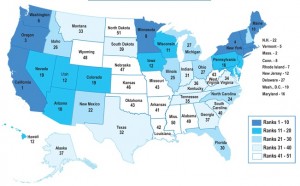Multifamily housing provides homes for over 40 million people around the country, and there is a huge potential for improvement in energy efficiency in the industry. State and local governments are moving rapidly to adopt benchmarking and disclosure laws as a part of their efforts to make existing buildings more energy efficient and lower energy bills for local residents. Six major cities (including Austin, Texas) and two states, have adopted disclosure and benchmarking laws for multifamily housing energy efficiency, totaling over 1.3 million housing units. The goal is to introduce competency and competitiveness in the multifamily housing industry that previously, was not seen. Most apartment buildings are 36 years old on average and were built prior to energy efficiency laws were in place. CNT energy conducted a study in 2012 with the American Council for an Energy Efficient Economy (ACEEE), which shows that energy efficiency upgrades in multifamily housing could save building owners and residents up to $3.4 billion annually. Where do most of the energy compliance problems exist? What repairs need to be completed to ensure energy efficiency?
- Air Ducts
The energy commission estimates that improper air duct installation is responsible for 20 to 40 percent of energy loss in residential buildings. Animals, rodents, and age can also result in tears or rips in duct work.
- Insulation
The standard width of insulation rolls is 16 inches. When the space between the floor and beams is narrower, many subcontractors will simply stuff the insulation into the space without cutting it to fit  properly. When insulation is compressed, it reduces the R-Value, a measurement of its insulation capability.
properly. When insulation is compressed, it reduces the R-Value, a measurement of its insulation capability.
- Framing
The energy commission advocates energy efficient design and construction methods that reduce the amount of framing and studs, and increase the amount of insulation. Generally speaking, the more framing that exists creates a greater chance of energy loss. Air penetrating through leaks in walls and framing can cause particles from fiberglass insulation to become airborne, causing potential respiratory problems. The potential for air leaks also increases and can be even greater in buildings with various ceiling heights.
- Windows
Heat gain through windows is responsible for 50 percent of the cooling load in warmer climates. Improperly installed windows are a major source of air and water intrusion from unconditioned spaces. Besides energy loss, water seepage can cause mold and decay, resulting in extensive damage.
- Roofing
The heat from a roof makes an air conditioner work even harder to cool a space. Leaks or gaps in tiles or shingles can create for leakage or water seepage that could result in structural damage and mold.
With energy costs on the rise by more than 20 percent, along with a greater focus on energy efficiency, multifamily housing can gain profitability by focusing on improvements and gain tenant loyalty.

